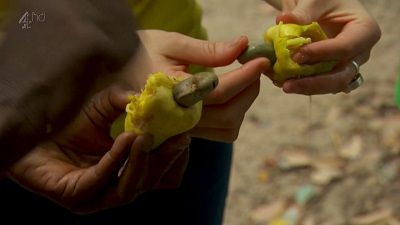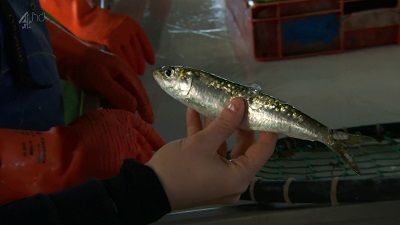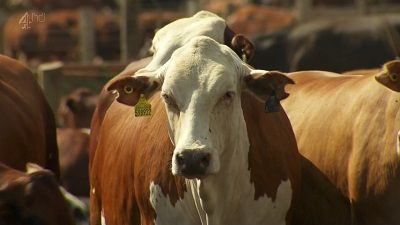The BEST episodes of Food Unwrapped season 2
Every episode of Food Unwrapped season 2, ranked from best to worst by thousands of votes from fans of the show. The best episodes of Food Unwrapped season 2!
The food and science series that travels the world to explore the industry secrets behind our favourite produce, industry secrets, and how foods are really made.

#1 - Cashew, Scampi and Salt
Season 2 - Episode 3 - Aired 6/17/2013
The team ask: Why are cashew nuts never on the supermarket shelf in their shells? What exactly is scampi? Does expensive salt taste different to cheap salt? Kate Quilton heads into the Mozambique countryside to find out why - unlike walnuts, hazelnuts and almonds - cashews aren't sold in their shells. She learns that cracking a cashew nut in its shell can do serious harm and getting a cashew safe to handle is a huge process. But the team also discover that an extract from the shell can have an extremely high value and could potentially be of great use to medical science and the war against superbugs. Jimmy Doherty's voyage of discovery to find out more about pub-favourite scampi and its processed cousin scampi bites gets off to a stormy start as he's sea sick on a Scottish trawler. He soon discovers that not all scampi is made equal. After carrying out DNA tests on a range of scampi products, Jimmy finds a surprising foreign body in this great British classic that takes him to some unexpected places. And why pay 20 times more for one type of salt than another? Matt Tebbutt learns how sea salt is harvested and finds out if the difference in taste is worth the price.

#2 - Sardines, Ducks and Pasta
Season 2 - Episode 8 - Aired 7/29/2013
Are fresh sardines better for us than tinned sardines? How much is known about the ducks we consume? And, when it comes to pasta, is fresh best? The search for sardines starts in Portugal and Kate Quilton is off to trawl for fish. She follows the fresh sardines from boat to dockside to a tinning factory. Sardines are heralded as a 'superfood' and jam-packed full of Omega 3 oils, but Kate wants to know if the tinning process diminishes their health benefits. Does the duck in supermarket packaging differ from the ducks we see in ponds? Jimmy Doherty goes duck-hunting to see how game meat differs from farm meat. But wild duck can only be hunted for five months of the year. We spend over £800 million on pasta each year in Britain. Supermarket shelves stock a wide range of dried and fresh pasta. Fresh pasta can cost ten times more than dried, but what are you actually paying for and does the price match the taste?

#3 - Chillies, Pork and Food Dye
Season 2 - Episode 6 - Aired 7/15/2013
Can hot chilies injure you? What's the difference between outdoor-bred and outdoor-reared pork? And what's bugging Jimmy about red food dye? Kate's in Mozambique, home to the peri peri chili, one of the most popular peppers in the world. Chili sauce is fiery, but what creates that burning sensation and can it harm you? To find out, Jimmy eats one of the hottest chili burgers in the world. His brain says serious damage is being done, but Jimmy asks a doctor if there are any physical effects. What makes chorizo red, and what is food additive E120, which is on the label? Jimmy finds out that a bug is responsible and visits Lanzarote, where he meets a farmer with some very unusual livestock. And presumably pork is either free-range or not, but is it really that simple?

#4 - Avocados, Eggs and Balsamico
Season 2 - Episode 7 - Aired 7/22/2013
Does a happy chicken lay a tastier egg? How do the supermarkets get avocados 'ripe and ready'? And why does one type of balsamic vinegar cost 100 times more than another? Kate visits Spain on the hunt for avocados. There are nearly 4000 trees on a farm near Malaga, producing half a million avocados. They need to be picked to ripen, but then their journey to the UK includes a surprise pit-stop at specialist ripening rooms in the Netherlands. Jimmy keeps chickens on his farm, and believes that a better-kept chicken produces a tastier egg. But he's never put it to the test, until now. Jimmy visits one of the UK's largest chicken farms, which produces a range of eggs: caged, barn, free-range and organic. How do they live, and does that affect the taste? Jimmy believes the feed is crucial to the bird and therefore the taste of the egg. But in a blind taste test, can he tell a free-range egg from a battery egg? Meanwhile, Matt is investigating balsamic vinegar: what is it made from and why does it have such a wide price range? He goes to Modena in Italy, where balsamic vinegar was invented.

#5 - Beef Stock, Processed Cheese and Corn Flakes
Season 2 - Episode 4 - Aired 7/1/2013
Jimmy, Kate and Matt ask how much cow is in a beef stock cube, how cornflakes are made, and what exactly processed cheese is. Jimmy tests stock - homemade versus a cube - and is surprised to learn that a cube isn't made the traditional way, from boiled bones. So what is the 'beef extract' referred to on the label? Jimmy heads to Brazil, to a company which produces a quarter of the beef that is consumed globally each year, to find out more about this mysterious ingredient. Iron is essential to the human body, carrying oxygen through the blood, but what does it look like? And why is it added to cornflakes? Processed cheese doesn't come in chunks or blocks but melts nicely all over a burger, so what's in it? Matt helps to make one and is shocked to learn that there could be as little as 10 per cent cheese in each slice and that it's even possible to make a yellow cheese-style slice with no cheese at all.

#6 - Kebab, Oysters and Gin
Season 2 - Episode 2 - Aired 6/10/2013
Jimmy Doherty asks: what exactly is in a doner kebab? After going to a kebab manufacturer and helping make a doner, Jimmy is pleasantly surprised by what constitutes a real one. But he soon discovers that a lot of kebab shops in the UK don't know which meat is in the doners they're selling. So, armed with a stack of random kebabs bought from around the country, Jimmy gets a specialist laboratory to carry out DNA tests. He has each sample tested for donkey, horse, lamb, beef, chicken and pork - and the results are varied. Meanwhile, Kate Quilton wants to find out the safest way of eating oysters. After seeing how they're caught she's shocked to discover that 75% of UK-caught oysters contain the sickness bug Norovirus. After seeing British oysters being cleaned for consumption, the team visit Health Protection England to find out the safest way to eat oysters without getting ill. And finally, Matt Tebbutt learns about the amazing ingredient that comes in every bottle of that classic English tipple gin.

#7 - Mouldy Bread, Chicken Kiev and Apples
Season 2 - Episode 1 - Aired 6/3/2013
The team ask: is mouldy bread safe to eat? Kate's on the trail of the chicken that goes into a Kiev. And Matt is puzzled: how can supermarkets sell English summer apples in the middle of winter? Jimmy travels to specialist cheese cellars in the south of France where mould is specially grown - to be eaten - before heading to Edinburgh to meet Britain's leading mould expert. Using specialist microscopes, Jimmy gets a unique insight into mould taking hold of bread to find out the difference between mould that is safe to eat and mould that can contain one the most deadly toxins known to man. Which is on your bread? Next the team head to Kiev in Ukraine to find out what part of a chicken makes a chicken Kiev. In a factory that processes around half a million birds a day Kate learns that a surprising number of chickens could end up in a single Kiev, and discovers how left-over chicken carcasses are turned into an unlikely food product.

#8 - Caffeine, Gum and Diet Bread
Season 2 - Episode 5 - Aired 7/8/2013
How is caffeine removed from coffee? What puts the chew into chewing gum? How are the calories counted in diet bread? Jimmy Doherty visits Brazil to find out more about coffee beans and to try to find a naturally grown caffeine-free coffee. Kate Quilton heads to Finland to find out what makes chewing gum so chewy and if it is safe to swallow. At a giant chemical plant she learns that many of the ingredients found in some of our gums can also be found in car tyres and other unlikely products. Matt Tebbutt counts the calories in diet bread. It looks and tastes similar but how are the calories sliced off?